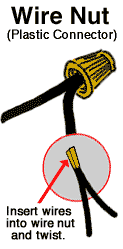Re: Zen switch anyone ?
Hahahaha! Touche. 🙂
But then you can also just twist them together. After all, sometimes you feel like a nut, sometimes you don't. 😀
se
jam said:.........not that I want to start an arguement or anything but you were wrong.
This is a Zen switch...............
Hahahaha! Touche. 🙂
But then you can also just twist them together. After all, sometimes you feel like a nut, sometimes you don't. 😀
se
That's PERFECT! Jam has the right idea... Only a real budget DIYer would touch it with his tongue to test for continuity.
😀
-David
😀
-David
current amp
Hi,
blue Led, Zen switch? nonsense!
Think is is much more interessting how this amp works. Can anybody comment the design? Nelson?
Reinhard
Hi,
blue Led, Zen switch? nonsense!
Think is is much more interessting how this amp works. Can anybody comment the design? Nelson?
Reinhard
Steve Eddy said:
Hehehe.
Naaaaaah. Too modern. Too high-tech.
Here's a nice Zen switch:
An externally hosted image should be here but it was not working when we last tested it.
se
This switch (circuit breaker) is great especially if you want manually interrupt current of some 10 kAmps 😉
Steve Eddy said:
Well, SOMEBODY died, dammit! 🙂
se
Are you thinking of Spalding Gray? Very sad tale.
whoa! Vonnnegut site has t-shirts with his famous "assterisk"
artwork. Perhaps I'll get some and send them to deserving folks on this site 😉
artwork. Perhaps I'll get some and send them to deserving folks on this site 😉
PMA said:This switch (circuit breaker) is great especially if you want manually interrupt current of some 10 kAmps 😉
Sure. Go ahead, Pavel. I'll watch from over...
...here. 😀
se
rif said:Are you thinking of Spalding Gray? Very sad tale.
THAT'S THE GUY!
Thanks, rif!
se
come back
Hello guys,
this thread is about `first watt´. Please come back!
Let us discuss the design of this Amp with picovolts of noise at the output.
Reinhard
Any idea Grey?
Nelson?
Hello guys,
this thread is about `first watt´. Please come back!
Let us discuss the design of this Amp with picovolts of noise at the output.
Reinhard
Any idea Grey?
Nelson?
What is noise?
Quiescent noise, hmmm .... what about "dynamic noise"? For instance, how much "noise" will the electrolytic power supply capacitors inject into the signal being amplified?
reinhard said:Let us discuss the design of this Amp with picovolts of noise at the output.
Quiescent noise, hmmm .... what about "dynamic noise"? For instance, how much "noise" will the electrolytic power supply capacitors inject into the signal being amplified?
Re: What is noise?
Being a Class A amplifier, the quiescent noise is the same as
the dynamic noise.
serengetiplains said:Quiescent noise, hmmm .... what about "dynamic noise"? For instance, how much "noise" will the electrolytic power supply capacitors inject into the signal being amplified?
Being a Class A amplifier, the quiescent noise is the same as
the dynamic noise.
Re: Here we go again......
Hmmmm..... but it could be worse - they could be focusing on
somebody else's stuff. 😎
MalichiConstant said:Oh great why not get the Chinese clone going before the first one is sold? I suppose you will have a schematic on the forum soon to expedite the process.
Hmmmm..... but it could be worse - they could be focusing on
somebody else's stuff. 😎
What is noise?
I should probably define my terms. By dynamic noise, I mean the total deviation from ideal amplification exhibited by an amplifier under dynamic conditions. How's that for a definition of noise? That deviation, in a manner of speaking, is present on the output only under dynamic conditions, so I call it dynamic noise. Because I don't know what ideal amplification looks like or should be, I admit not having a workable definition on my hands here. But I do know that, for instance, changing the type or quality of capacitor used in a power supply changes the sound of an amplifier ... ie, trades one form of noise generation for another. I'm betting that lowering quiescent noise doesn't much affect, or at least does not eliminate, noise generated by power supply capacitors.
Nelson Pass said:
Being a Class A amplifier, the quiescent noise is the same as
the dynamic noise.
I should probably define my terms. By dynamic noise, I mean the total deviation from ideal amplification exhibited by an amplifier under dynamic conditions. How's that for a definition of noise? That deviation, in a manner of speaking, is present on the output only under dynamic conditions, so I call it dynamic noise. Because I don't know what ideal amplification looks like or should be, I admit not having a workable definition on my hands here. But I do know that, for instance, changing the type or quality of capacitor used in a power supply changes the sound of an amplifier ... ie, trades one form of noise generation for another. I'm betting that lowering quiescent noise doesn't much affect, or at least does not eliminate, noise generated by power supply capacitors.
- Status
- Not open for further replies.
- Home
- Amplifiers
- Pass Labs
- Any new news on FirstWatt??
